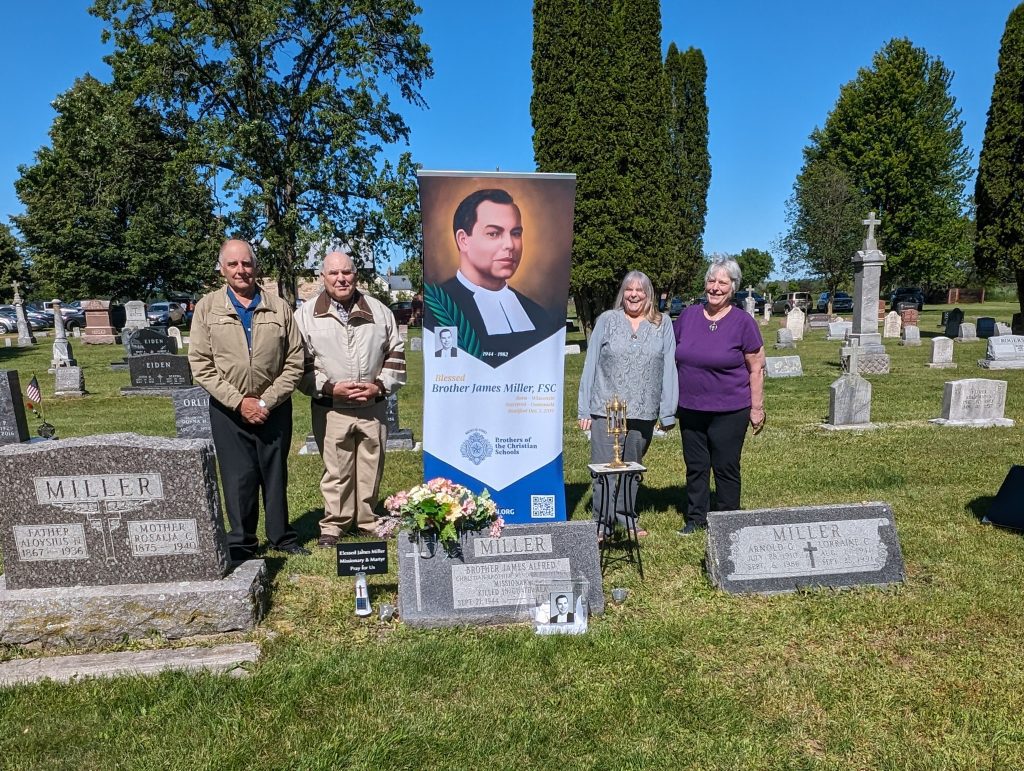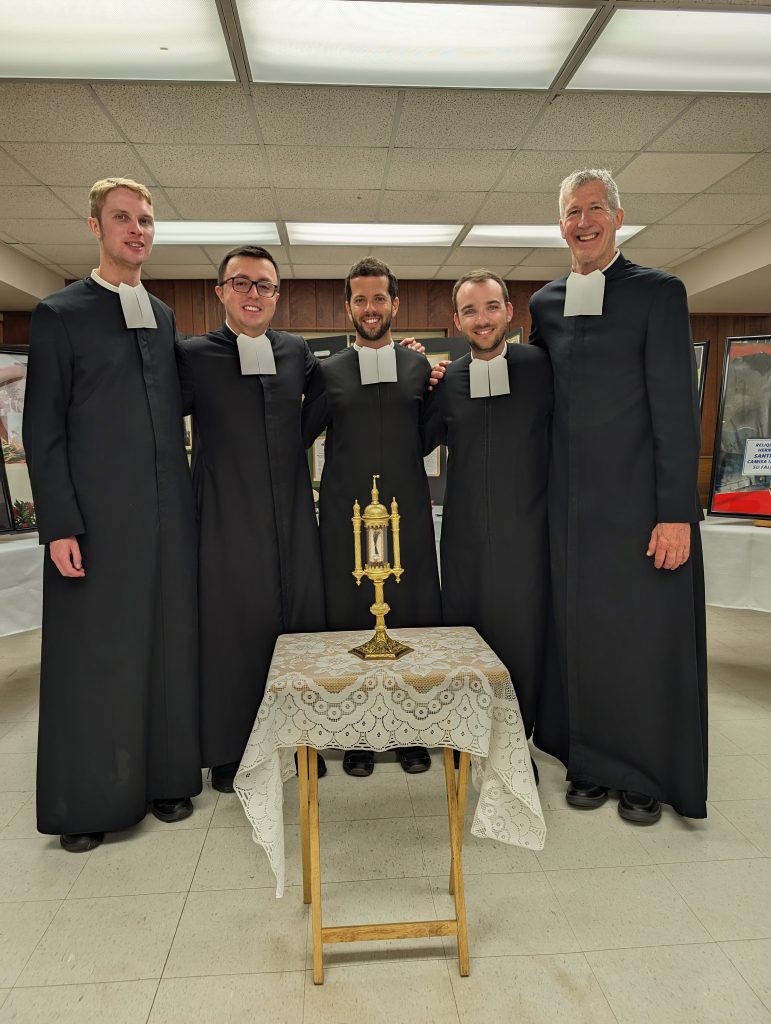By Tom Southard
On Monday, June 10, the National Eucharistic Pilgrimage stopped at St. Martin Church Cemetery in Custer, Wisconsin — population: 2,532. This seemingly unremarkable rural churchyard has hundreds of graves dating back to the mid-19th century, when St. Martin’s was the German parish and nearby St. Joseph’s was the Polish parish.
This small site houses the final resting place of Blessed James Miller, martyr and Brother of the Christian Schools.

Not knowing what to expect, I arrived about 90 minutes before the pilgrims and encountered Mr. Yenter, who was walking through the rows of graves praying the rosary. A few years ago, Mr. Yenter retired from the local paper mill and has since assisted with the upkeep of the cemetery at the now-closed parish. He had just finished setting up chairs for the family and close friends of Brother James who would be arriving shortly. As he came to greet me, he was excited to point out the Miller family farm that was within sight of Brother James’ grave. He told me what an honor it was to help out with the cemetery and to take care of Brother James’ grave.
The next to arrive were Jane and Debbie, who came from Sacred Heart Parish in Polonia to help. Sacred Heart is the parish that was created at the merger of St. Martin’s and St. Joseph. They told me how important Brother James is to the parish, and to them personally. Every Mass at Sacred Heart ends with prayer for his canonization.
At Cretin High School (now Cretin-Derham Hall) in St. Paul, Minnesota, where Brother James taught before being sent to Nicauragua and later Guatemala, students called him “Brother Fix-It.” A handyman par excellence, Brother James was often seen with a wrench in his hand or helping the young men remember their locker combination.
Widows at Sacred Heart ask the intercession of Brother James as “Mr. Fix-It” when they need help. I heard about a woman who had a mouse in her house and prayed to “Mr. Fix-It” and the mouse was gone that same night. Another woman had a concern about the wiring in her light and prayed to “Mr. Fix-It” and the next day her nephew stopped by and offered to take care of it.

When the Miller family arrived, Jane and Debbie introduced me. I soon learned that Bill, Ralph, Pat, and Louise are very proud of their brother. They showed me the generations of Millers (formerly Muellers) in the cemetery. Although they still feel the grief of losing a sibling at such a young age, they are so proud of what their brother did, and are glad he resides with his family. Brother James is buried between his parents and grandparents, with a gravestone that simply reads, “Brother James Alfred, Christian Brothers, Winona Province, Missionary, Killed in Guatemala.”
By 10 a.m., over 250 people were gathered around the grave. The simple yet beautiful service was led by Brother Larry Schatz, FSC, of the Midwest District. The Brothers took turns reading from Brother James’ words, and Brother Stephen Markham, FSC, offered a reflection on his life.
After the ceremony, we were invited to Sacred Heart parish church hall for breakfast, made and served by a group of parishioners. The meal included cheesy potatoes and paczki, Polish donuts. I asked some of the ladies of the parish about Brother James. One told me she was in first grade at the grammar school attached to St. Martin’s when Brother James was in sixth grade there, and she remembered him fondly. I asked if she was surprised when she found out that he was going to be named a Servant of God, the first move toward canonization. She told me not at all: “He was a saint on earth. He always took care of the younger kids. I remember him tying the shoes of kids walking by who couldn’t do it themselves. He was kind to everyone in the hallway and he knew everyone’s name.”
A pilgrim asked Brother Stephen about Brother James’ piety. Brother Stephen replied that he was no more or less pious than any Brother (“He might have been late to prayer more often than most Brothers, though”). His commitment to ministry; his understanding of the importance of educating young people, especially the poor; and his care for others came from his faith, was what made him such a good Brother.

Later in the evening, there was a presentation in the town of Marshfield on Brother James’ life. The presenter, Father Alan Guanella, a Saint Mary’s University of Minnesota graduate, said of him: “There was no job beyond his capabilities or beneath his dignity.” Father Alan spoke of Brother James’ humor as always present in the work he did.
When discussing the great danger he was in in Guatemala, Brother James once said, “We don’t know when we rise in the morning if we will be alive by nightfall.”
In response to a question on how he could continue his ministry, he said, “The need to help these poor uneducated people is so great that it is the all-consuming motive for being there.” This underscored for me Brother James’ beautiful witness to Saint John Baptist de La Salle’s call to a human and Christian education to the young, especially the poor.
Perhaps the greatest words of faith in his ministry come from Brother James himself in his last letter: “I have been a Christian Brother for nearly 20 years now, and my commitment to my vocation grows steadily stronger in the context of my work in Central America. I pray to God for the grace and strength to serve him faithfully by my presence among the poor and oppressed of Guatemala. I place my life in his Providence; I place my trust in him.”
I learned a few important things about Brother James during this trip. We see him as a pious teacher, committed to students, which he was. But he was also a well-loved family man, committed to his De La Salle Brothers and his family brothers and sisters. He loved his students, and believed deeply that education would make their lives better. And at the end of the day, he was just a man, doing the best he could. We hold up our saints and blessed and sometimes forget that we all can find holiness in what we do; Brother James found that holiness.
Let us pray for his canonization and for the continuance of the Lasallian educational mission that was so important to Blessed James.
Tom Southard is executive director of Christian Brothers Conference.
Visit brotherjamesmiller.org to learn more about Blessed James Miller and his cause for canonization.